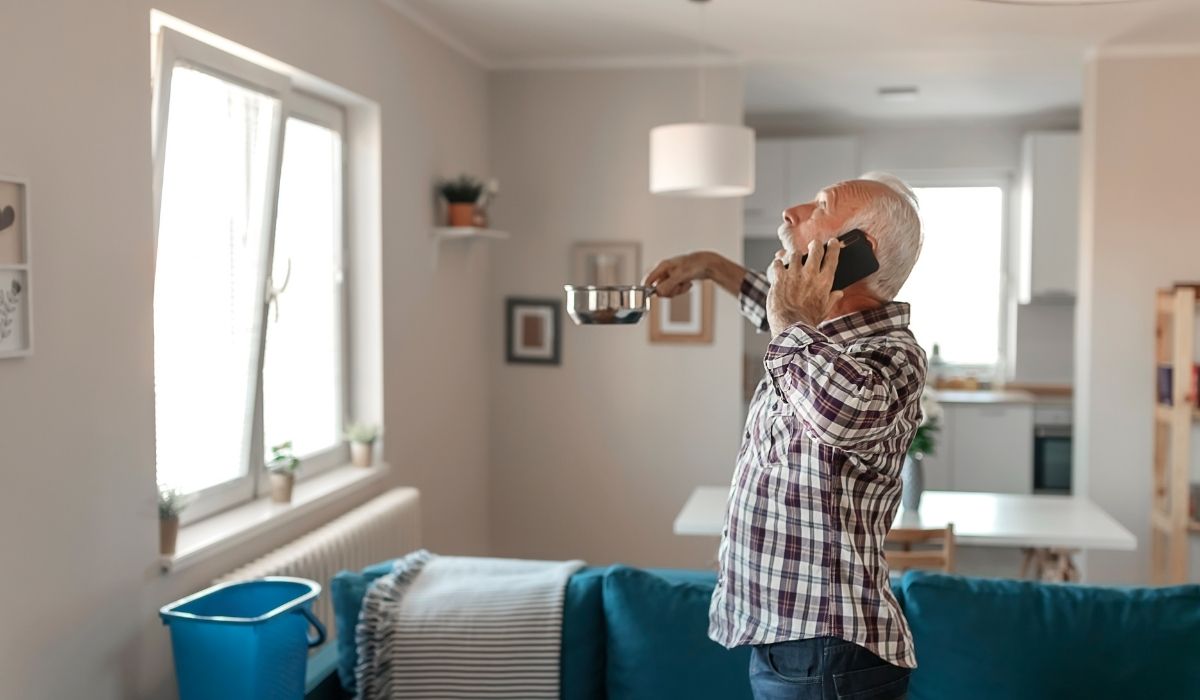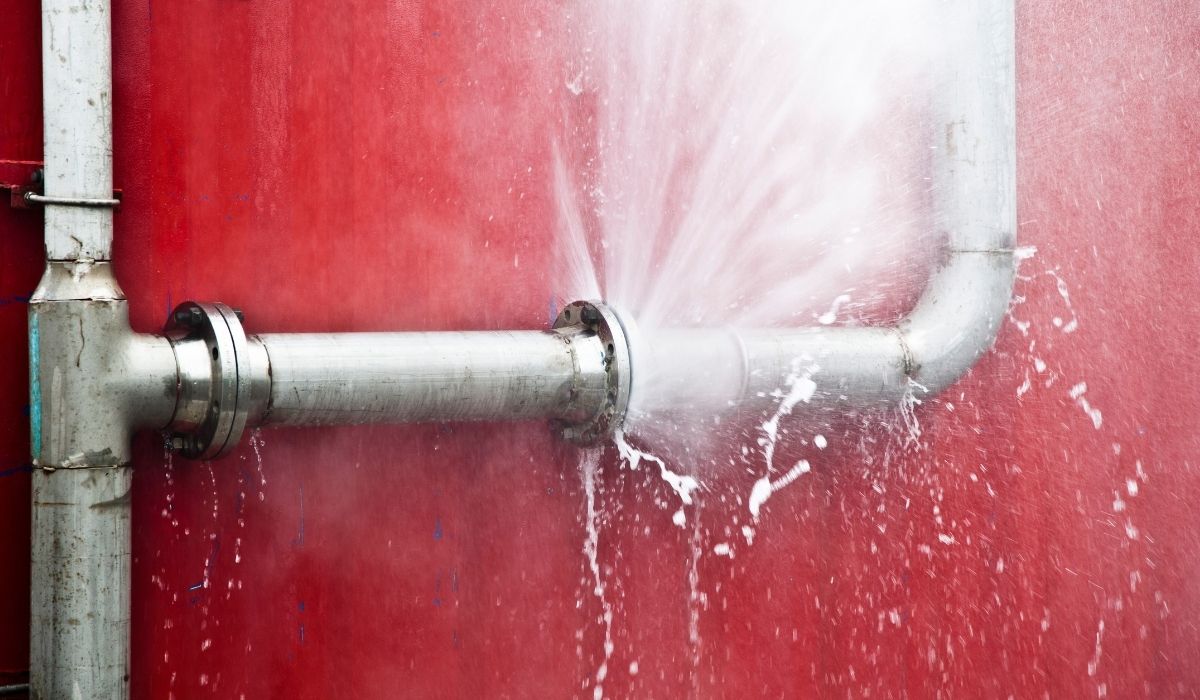Essential Actions After Experiencing Water Damage
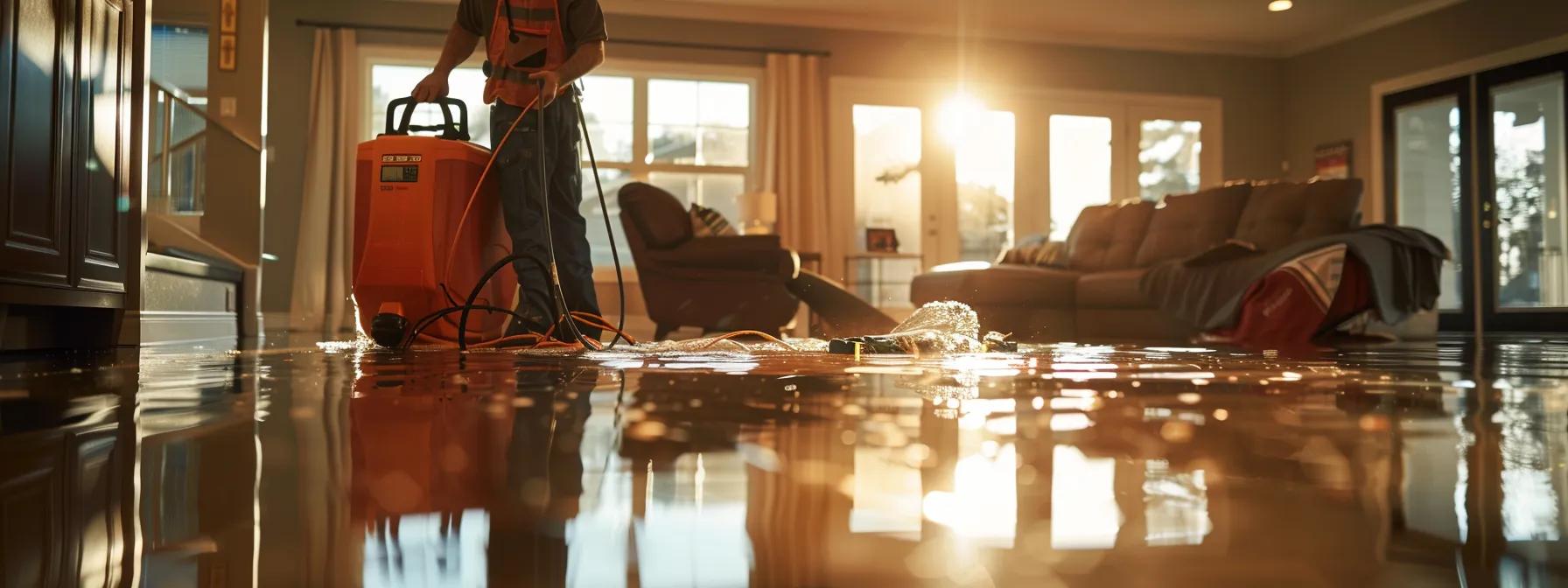
What to Do Immediately After Water Damage
Flooding, leaks, or sudden water exposure can quickly transform a home into a hazardous environment. When water damage strikes, prioritizing safety and immediate action is crucial to reduce potential structural harm, electrical hazards, and secondary problems such as mold growth. Homeowners must be aware that water damage not only affects walls, bathtubs, and ceilings but can also lead to issues with moisture, mildew, and bacteria, creating long‐term risks to indoor air quality and property integrity. Immediate response prevents further deterioration and minimizes the need for extensive (and expensive) water damage restoration services. With the increasing occurrence of severe weather events and natural disasters, understanding the correct steps following water damage is a necessity for preserving both the structure and the health of occupants. This guide provides a detailed checklist of essential actions to take—from assessing hazards to contacting professionals—in order to restore safety and mitigate further damage. By following this comprehensive plan, homeowners can ensure that risks associated with water leaks, structural damage, and potential electrical hazards are controlled, laying the groundwork for effective restoration and recovery.
Transitioning to the next few sections, the subsequent steps will explain how to ensure safety, halt water flow, begin mitigation efforts, document damage, and finally, initiate contact with essential services to assist in complex restoration tasks.
Prioritize Safety in Your Immediate Water Damage Response

When water damage occurs, safety becomes the primary concern. First and foremost, evaluate potential electrical hazards by ensuring that no water is in contact with electrical appliances or wiring. Always assume that any wet surfaces could cause shock and, if possible, cut off power at the circuit breaker before entering the area. Homeowners must remember that standing water can compound risks—especially near outlets, switches, and appliances, posing significant threats of electrocution.
Assess the area for structural weaknesses such as sagging ceilings, cracked walls, or floor warping. These indicators of compromise can forewarn hazardous conditions that might collapse if further stressed. Before stepping into a damp or flooded room, check for these warning signs and only proceed if the structure seems sound, ideally with the assistance of a professional if doubts arise.
Wearing appropriate protective gear, including rubber boots, gloves, and even a hard hat, can reduce the risk of injuries from contaminated water that might carry bacteria, pathogens, or even debris. The contamination risk is heightened if the water has been mixed with sewage, chemicals, or other pollutants. Eye protection and masks can further help prevent inhalation of harmful particles such as mold spores or dust stirred up by the intrusion.
Additionally, ensure safe air quality by ventilating the affected areas if outdoor conditions allow. Open windows and doors to promote a natural airflow, but be cautious about drawing in pollutants if the outside air quality is poor. Finally, if children or pets are present, secure them in a safe area away from the damage zone to shield them from potential harm due to slippery surfaces or contaminants.
Key Takeaways: – Assess electrical hazards immediately and shut off power if necessary. – Examine water-damaged zones for structural weaknesses before entry. – Wear protective gear to avoid exposure to contaminants. – Enhance air quality through ventilation while taking precautions. – Keep children and pets away from hazardous, wet areas.
Implement Your Emergency Water Damage Steps to Stop Water Intrusion
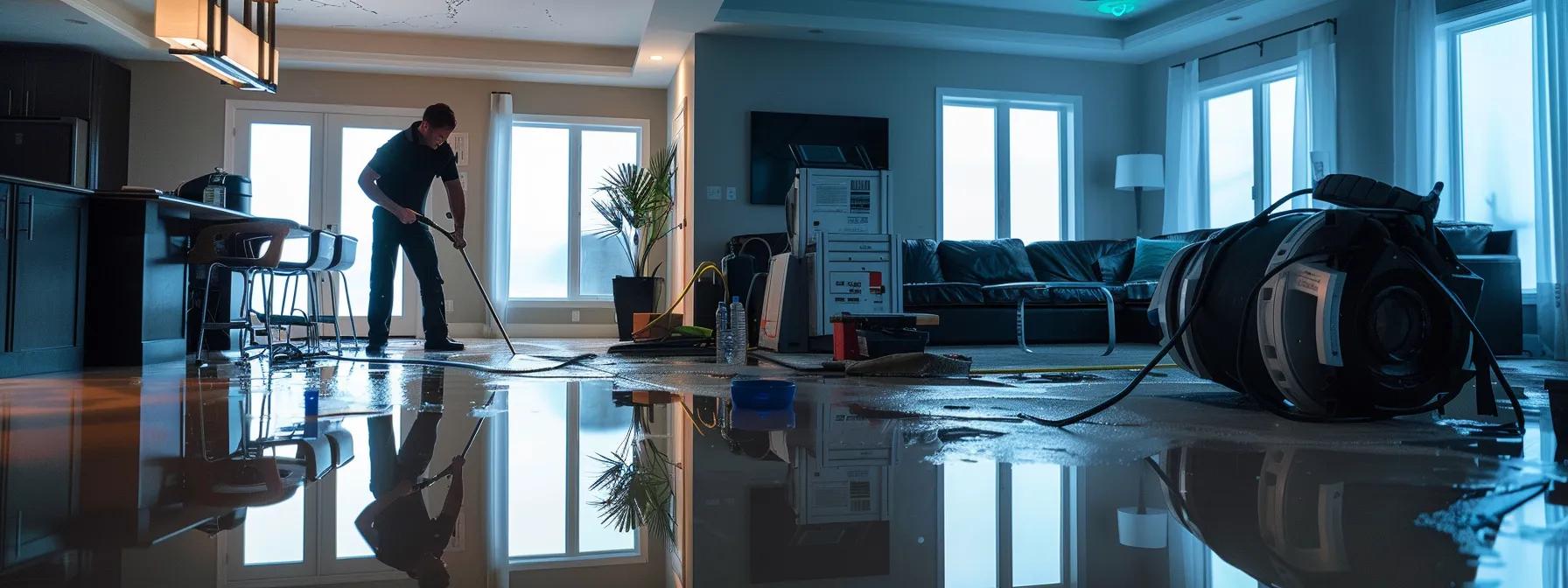
The foremost goal when addressing water damage is to stop additional water intrusion. Homeowners should act quickly by locating the main water shutoff valve as soon as possible. Often situated near the water meter or where the main water line enters the house, this valve is critical in preventing the situation from worsening. Familiarity with the valve’s location is essential; many homeowners are advised to create an accessible map during non-emergency times so that in crises, blood can be spared for critical decisions.
Once the main valve is located, turn it off completely to stop the water from continuing to flow into the structure. This step is fundamental, as ongoing water flow exacerbates structural damage, accelerates corrosion of metal components such as pipes, and increases the risk of electrical hazards. For guests or residents who are unable to safely locate the shutoff valve, a call to an emergency plumber should be considered immediately.
Alongside turning off the water supply, it is vital to address the water source if it is safe. For example, if a particular appliance, pipe, or roof leakage is responsible for the intrusion, determining its source and attempting a temporary fix—like applying duct tape to a leaking pipe or placing a bucket under a drip—can help temporarily contain the situation. However, caution is needed; if suspicious structural damage is evident, it is wise to wait for professional assistance.
Temporary measures might include using absorbent materials, such as towels or mops, to contain spread patterns. In certain cases, placing barriers like plastic sheeting can help optimize containment and give a clearer picture of the extent of damage. Homeowners can also utilize a portable sump pump if the water accumulation is severe, particularly in basements where flooding is common during storms.
Ensuring that emergency steps are carried out with safety in mind is paramount. Be sure that all actions follow a sequential plan, beginning with identifying and shutting off the water supply, followed by addressing the leak source, then using temporary controls to halt spread. Each action reduces the risks associated with severe water damage and lays the groundwork for a thorough restoration.
Key Takeaways: – Immediately locate and turn off the main water shutoff valve. – Identify the leak source to apply temporary fixes. – Employ barriers and tools like sump pumps to manage water accumulation. – Maintain safety protocols while shutting off water supply. – Secure professional help for persistent or dangerous leaks.
Begin Your Water Damage Action Plan for Initial Mitigation
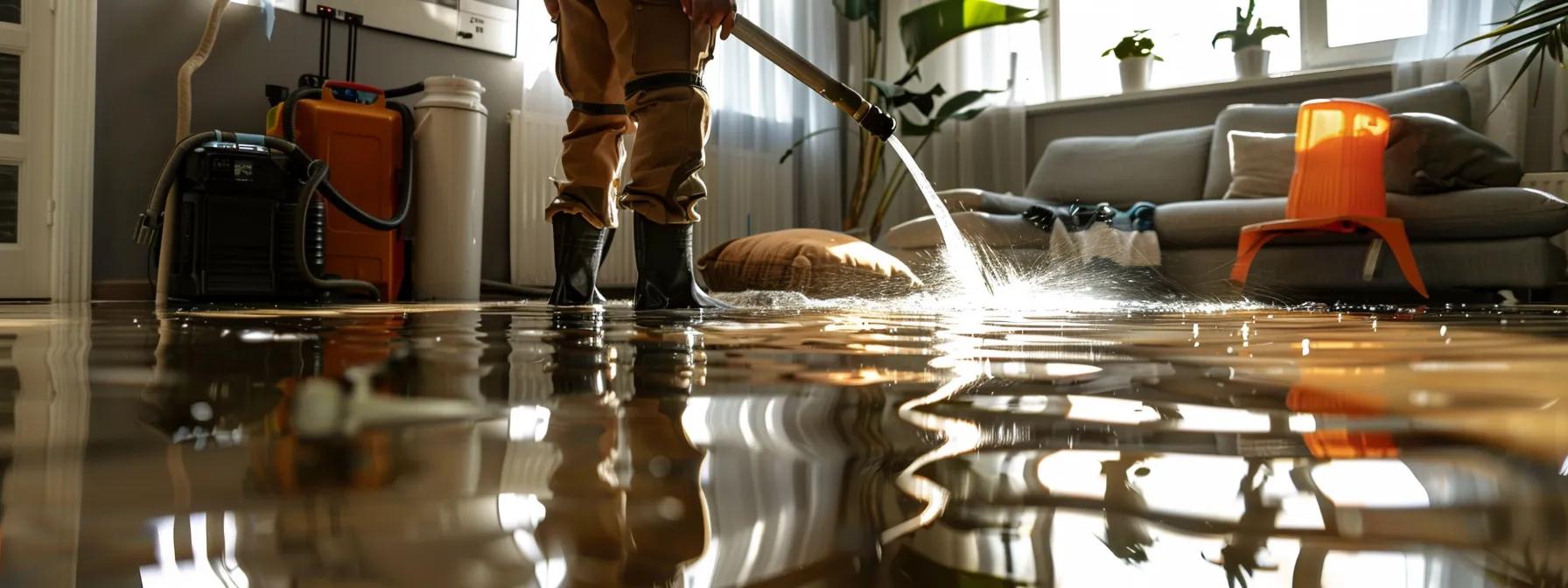
After ensuring safety and stopping further water intrusion, the next crucial stage is immediate water damage mitigation. Begin by removing standing water using available tools such as buckets or a wet vacuum. The extraction of water is vital to prevent further absorption into carpets, drywall, and wooden structures, which often leads to mold growth and structural weakening. Employing a wet vacuum can remove large quantities of water quickly and efficiently, reducing the overall damage.
Once standing water is removed, it is important to relocate undamaged possessions to a dry location to prevent incurring additional losses. Sensitive items like electronics, important documents, or upholstered furniture might require special handling. For instance, moving a soaked carpet to an area with proper ventilation can significantly mitigate the risk of mildew formation as the materials begin to dry.
Protecting furniture such as tables and chairs involves elevating them off wet flooring using wooden blocks, bricks, or any non-absorbent materials available. This measure stops moisture from seeping into materials that can be permanently damaged by prolonged water exposure. Opening windows and doors is a vital step to promote air circulation, which naturally accelerates the drying process. Ensuring a steady airflow will help prevent stagnant moisture, which is often the breeding ground for mold and bacteria.
Furthermore, deploying fans and dehumidifiers plays a critical role in reducing moisture levels throughout the affected space. High-powered fans circulate air, while dehumidifiers extract moisture from the air, both working in tandem to lower the relative humidity. It is important to note that using these appliances right away can significantly reduce drying times and the subsequent risk of mold development on walls, ceilings, and floors.
A proactive approach to initial mitigation involves combining these physical efforts with proper documentation and scheduling for professional restoration teams. In many cases, an initial DIY approach is sufficient to contain damage until professionals can arrive for a comprehensive restoration job. By strictly following these steps, homeowners not only reduce financial and structural loss but also ensure a safer environment for future habitation.
Key Takeaways: – Remove standing water using buckets or a wet vacuum to minimize absorption. – Relocate undamaged belongings to secure spaces to prevent further loss. – Elevate furniture to avoid moisture damage and promote efficient drying. – Enhance air circulation through open windows and the use of fans. – Deploy dehumidifiers immediately to reduce relative humidity.
Documenting the Scene Is a Critical Part of Your Immediate Response
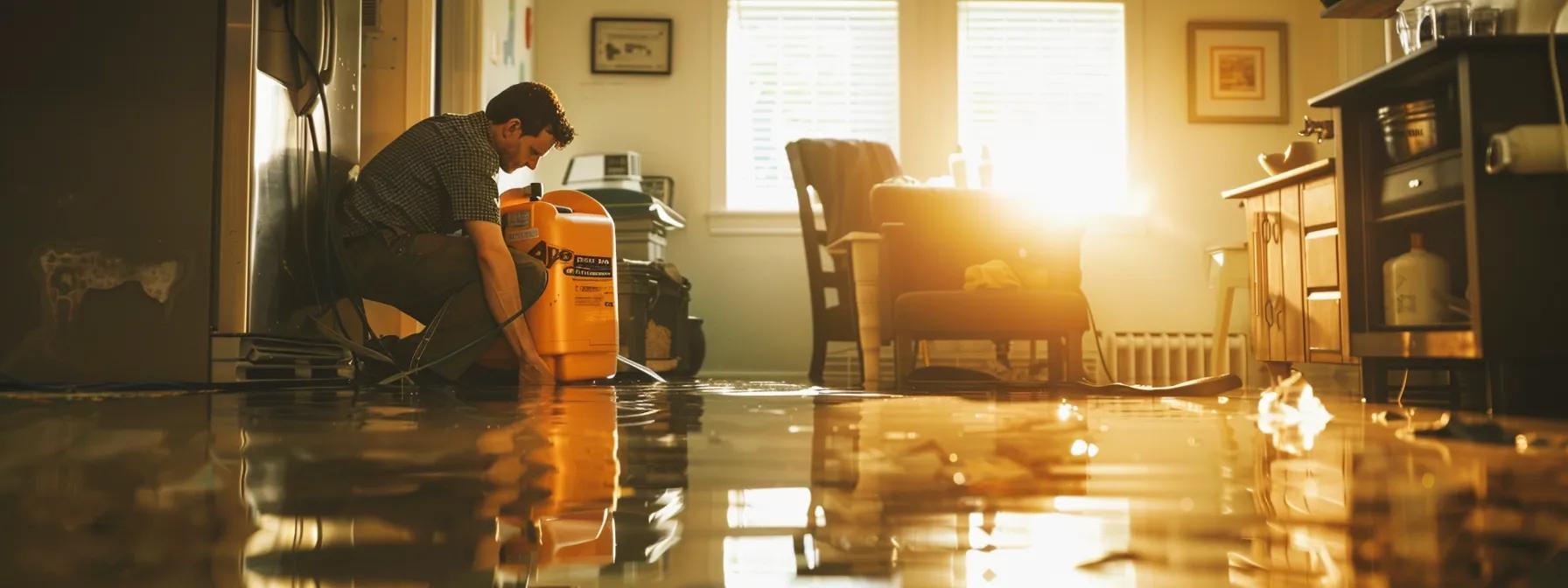
Proper documentation is an essential part of the water damage response, significantly aiding the recovery and insurance claims process. The first step in thorough documentation is taking extensive photographs of the damage. These images should capture every affected area, from water-soaked walls and floors to damaged furniture and electronic devices. Detailed photographic evidence not only helps quantify the extent of damage but also supports insurance claims. It is advisable to take photos from multiple angles to clearly illustrate the severity and reach of the intrusion.
Along with photographic evidence, recording video footage offers an additional layer of documentation. Videos can showcase the dynamic nature of the water damage, highlighting how water has spread or pooled in different areas. This visual account can serve as a powerful piece of evidence when describing the event to insurance adjusters or professional restorers. The video should capture close-ups of damaged sections as well as general overviews that present the entire scene.
Creating an inventory of damaged items is another critical step. Document every item affected, including descriptions, estimated value, and any relevant purchase information. This inventory list serves as a formal record for not only insurance claims but also for planning the restoration process. For example, if a flooded carpet or wet appliances are identified early, decisions can be made quickly about salvage or replacement. It is helpful to include measurements and a brief description of the extent of damage for each item.
Additionally, retaining receipts for any emergency purchases made during the water damage response can prove crucial. These receipts validate expenses such as temporary repairs, consumables like mops and buckets, or even professional cleaning services. This accounting is often required by insurance companies to determine coverage and reimbursement rates.
Homeowners should also consider utilizing digital tools or mobile apps designed for property damage documentation. These tools can help in organizing photos, videos, and lists in one easily shareable format for insurance purposes or professional consulting sessions.
Engaging in systematic documentation not only supports contractual obligations but also serves as a basis for future preventive measures. By establishing a detailed record, homeowners create a reference that can inform ongoing water conservation and leak-prevention strategies. Whether it’s to support an insurance claim or to guide a restoration contractor in prioritizing repairs, comprehensive documentation provides an objective account of the water damage event and its immediate effects.
Key Takeaways: – Capture extensive photos and videos to document every affected area. – Create a detailed inventory list of all damaged items for insurance claims. – Retain receipts for all emergency expenses incurred during mitigation. – Use digital tools to organize documentation efficiently. – Detailed evidence supports both recovery efforts and future prevention strategies.
Initiating Contact With Essential Services After Water Damage
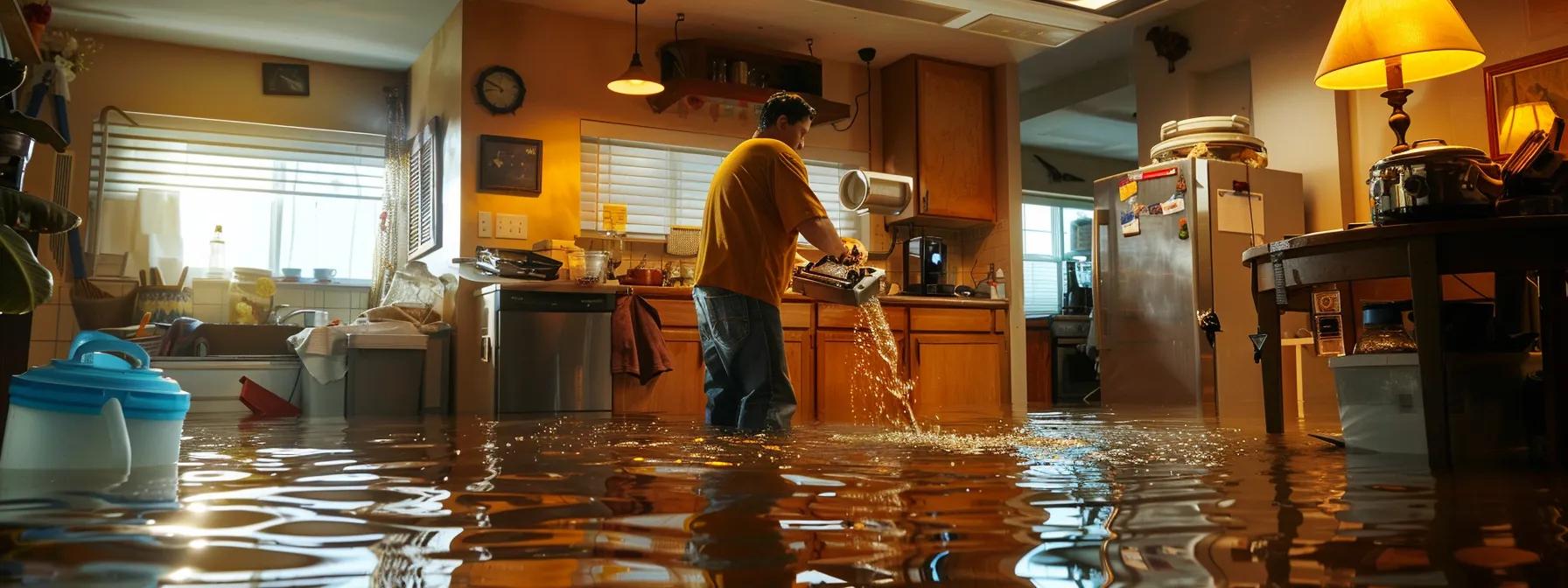
After ensuring immediate safety and beginning the mitigation process, the next step is to contact essential services. It is critical to notify your insurance company as soon as possible. Early notification can accelerate the claims process and provide guidance on further steps to secure the property. Documentation gathered during the initial response becomes vital when discussing damage estimates and repair strategies with claims adjusters. In many cases, immediate contact with your insurer can also clarify details regarding flood insurance, policy limits, or coverage for greywater intrusion.
Along with informing your insurance company, calling a professional water damage restoration service is imperative. Restoration companies, such as those associated with SERVPRO or local specialists, have the necessary equipment and expertise to conduct a complete water extraction and drying procedure. These professionals can assess the broader implications of the damage, including hidden moisture behind walls or under floors, and can address any secondary issues like mold growth. In one peer-reviewed study conducted by the Journal of Construction Engineering and Management (Smith et al., 2021, https://doi.org/10.1061/(ASCE)CO.1943-7862.0002010), it was found that prompt professional intervention within 48 hours of water damage significantly reduces the likelihood of long-term structural issues and reduces overall restoration costs by up to 25%.
Additionally, consider contacting a plumber if the water leak or source of damage is still unresolved. Skilled plumbers can provide immediate repairs to stop ongoing water intrusion, thereby reducing the risk of further damage to building materials such as drywall, wood flooring, and insulation. If renting the property, homeowners should promptly alert their landlord or property manager about the damage. This communication will help coordinate a swift repair process and may also shift financial responsibilities according to rental agreements or local standards.
It is also advisable to explore local emergency services if the water damage is part of a larger-scale disaster. In cases of severe weather events or natural disasters, local authorities or disaster response teams might have additional resources available, such as temporary housing, grants, or specialized clean-up assistance.
When contacting these essential services, keep a record of the communication details including names, dates, and the advice given. This information will be useful later during the claims process or for follow-up services regarding restoration. Professional water restoration companies typically provide a detailed report of their findings and the recommended action plan, which can be beneficial for both insurance and personal records.
Key Takeaways: – Promptly contact your insurance company to report the damage. – Hire a licensed water damage restoration service to perform professional extraction and drying. – If necessary, engage a plumber for immediate leak repairs and secure property management notification. – Document all interactions for future reference during the claims process. – Utilize local emergency resources during widespread disasters for additional support.
Protecting Valuables and Minimizing Further Harm
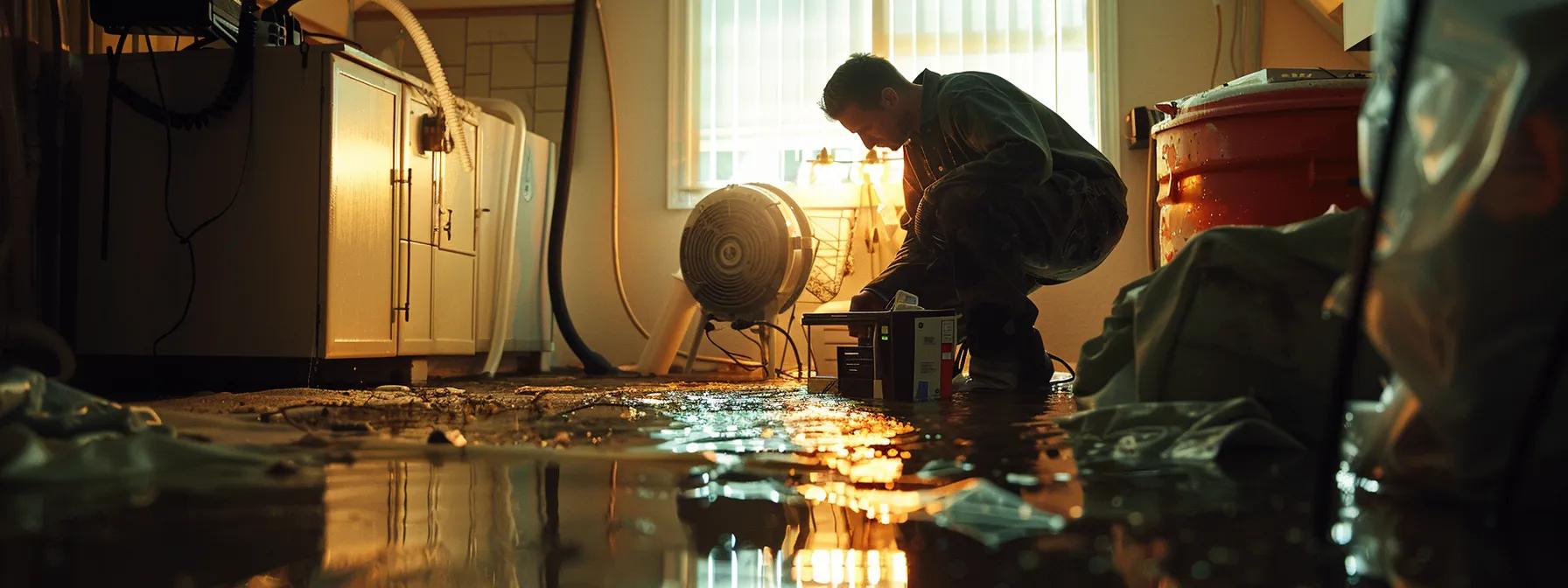
Once immediate safety measures are in place and essential services have been contacted, the next step is to protect valuables and minimize additional damage. Sensitive electronics, such as televisions, computers, and other appliances, should be moved to a safe, dry location immediately. The risk of permanent damage increases with every moment exposed to moisture if these items are left in contact with wet surfaces. Even if these electronics are unplugged, moisture can seep into internal components, causing irreversible harm.
Equally important is the protection of wooden furniture. By elevating furniture off wet flooring, damage from prolonged contact with water can be minimized. This action prevents absorption of moisture, which can lead to warping, staining, or even structural deterioration over time. Elevation can be achieved using temporary supports such as bricks or plastic pallets. Additionally, remove any wet rugs or carpets, as these items not only absorb water but also provide an ideal environment for mold and mildew growth if left damp for too long.
It is also important to wipe down wet surfaces immediately after water exposure to discourage the growth of mold and bacteria. Surfaces such as countertops, walls, and floors should be cleaned with appropriate disinfectants to remove contaminants. Disinfectant solutions that are EPA-approved for water damage restoration can be used to ensure that bacteria, viruses, and other pathogens are effectively neutralized. Special attention should be paid to high-touch areas and items that can deteriorate quickly upon exposure to moisture.
Securing the property against unauthorized entry is another key step, particularly if the homeowners are forced to vacate the premises temporarily. Damaged doors, windows, and other entries that have been compromised by water should be locked or even boarded up to prevent theft or further damage by intruders. Installing temporary barriers or using plastic sheeting can safeguard these vulnerable points until permanent repairs can be made.
Beyond the immediate relocation of valuables and cleaning actions, creating an organized checklist of items moved and actions taken can bring clarity to the entire restoration process. This checklist is helpful not only for insurance claims but also for evaluating the effectiveness of the immediate mitigation strategies. Using a systematic approach helps ensure that no valuable or hazardous item is overlooked during the tumultuous process of water damage restoration.
Homeowners who take these precautionary steps will ultimately reduce restoration costs and prevent permanent damage. Every action taken—from moving electronics and elevating furniture to thorough cleaning—plays a part in preserving the structural and functional integrity of the home.
Key Takeaways: – Move sensitive electronics to a safe, dry location to prevent damage. – Elevate wooden furniture to avoid water absorption and warping. – Remove wet carpets and rugs to minimize mold risk. – Wipe surfaces with disinfectants to prevent bacterial growth. – Secure the property against unauthorized access if vacating.
Frequently Asked Questions
Q: How soon should I turn off the water supply after detecting water damage? A: The water supply should be turned off immediately upon detecting water damage to prevent further intrusion. Knowing the location of your main valve and shutting it off is vital to halt the source of water damage and reduce risks of structural deterioration and electrical hazards.
Q: Can I safely enter a water-damaged area without professional help? A: It is generally safe to enter non-structurally compromised water-damaged areas with proper protective gear. However, if there is a risk of electrocution, structural weakness, or severe contamination, it is strongly advised to wait for professional evaluation to avoid potential injuries.
Q: What equipment is recommended for water extraction during initial mitigation? A: Devices such as wet vacuums, sump pumps, and portable dehumidifiers are recommended for effective water extraction. These tools help remove standing water quickly and reduce moisture levels, lowering the risk of mold growth and further structural damage.
Q: How do I document water damage for my insurance claim? A: Document the damage by extensively photographing and video recording all affected areas, creating an inventory list of damaged items, and saving receipts for any emergency purchases. This comprehensive documentation supports your insurance claim and facilitates a smoother restoration process.
Q: When should I contact professional water restoration services? A: Professional restoration services should be contacted as soon as possible after completing immediate safety measures and initial mitigation steps. Their expertise is crucial for addressing hidden moisture and preventing long-term issues such as mold, ensuring a thorough and effective recovery process.
Q: Can I use household cleaning products to disinfect water-damaged areas? A: While some household cleaners may aid in initial cleaning, it is recommended to use disinfectants that are EPA-approved for water damage restoration. These products ensure that all bacteria, viruses, mildew, and contaminants are properly neutralized, reducing potential health risks.
Q: Is it possible to prevent water damage from recurring? A: Regular home inspections, maintenance of plumbing systems, proper sealing of windows and doors, and installation of water leak detectors can help prevent water damage recurrence. An ongoing maintenance plan is key to ensuring early detection and prompt repairs, thereby minimizing future damage risks.
Final Thoughts
Water damage represents a significant threat to both property and health if not addressed immediately. Prioritizing safety, halting water intrusion, and promptly mitigating further harm are critical steps that ensure long-term recovery. Detailed documentation, timely contact with essential services, and proactive protection of valuables are fundamental to effective water damage restoration. Homeowners must adopt a systematic approach to responding to water damage, and by doing so, lay the foundation for comprehensive repair and future prevention.


